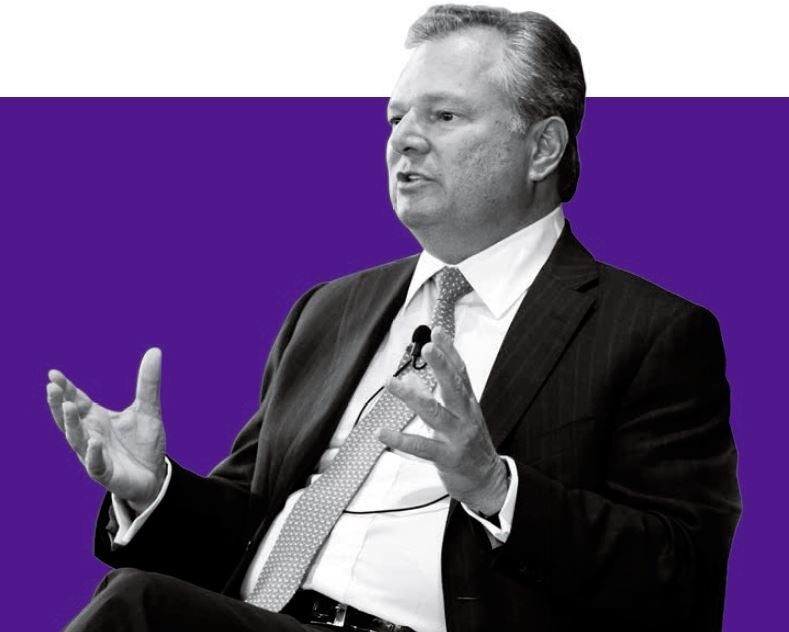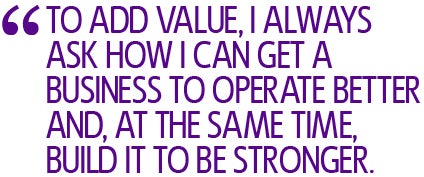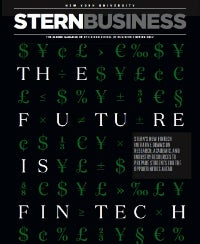[no-title]

A Conversation with James Cracchiolo (BS '80, MBA '85), Chairman and CEO of Ameriprise Financial
James Cracchiolo has been the chairman and chief executive officer of Ameriprise Financial and its predecessor company since 2000. In 2005, American Express Financial Advisors completed its spinoff from American Express and became Ameriprise Financial. Cracchiolo guided Ameriprise, a diversified financial services firm and the leading financial planning company in the US, through its first decade as a public company while generating strong shareholder value.
Prior to his current role, he held a number of executive positions at American Express, including leading businesses with significant domestic and global operations. He has served on the boards of directors of the American Council of Life Insurers and the Financial Services Roundtable, and on the board of advisors to the March of Dimes Foundation. Cracchiolo holds a BS in accounting and economics and an MBA in finance, both from NYU Stern.
He was interviewed on October 10, 2016, by Matthew Richardson, the Charles E. Simon Professor of Applied Economics.
MATTHEW RICHARDSON: Tell us about your experience at Stern.
JAMES CRACCHIOLO: I participated in the MBA program at night, a time when the curriculum was geared to both theoretical and practical learning. The professors were at the top of their fields, and many of them worked in industry, finance, and banking during the day. Students gained a great breadth of knowledge from these professors to draw on once they started their careers.
MR: You started as a public accountant at Ernst & Whinney, then joined American Express. What was your career path to CEO of Ameriprise?
JC: I started at American Express as comptroller for a new direct merchandising business, which we grew to almost half a billion dollars in revenue. The business grew significantly and when we had to consolidate its operations, I expanded my responsibility to include overseeing their back office operations. From there, I was asked to be CFO of American Express Centurion Bank and we built the non-bank financial institution business to almost $10 billion in assets.
business, which we grew to almost half a billion dollars in revenue. The business grew significantly and when we had to consolidate its operations, I expanded my responsibility to include overseeing their back office operations. From there, I was asked to be CFO of American Express Centurion Bank and we built the non-bank financial institution business to almost $10 billion in assets.
Next, I helped build a very successful consumer lending business. So I moved from finance to operations, back to finance, to general management in the early days of my career, which was very helpful. In the late ’80s, American Express acquired a number of businesses and put them under the Shearson Lehman umbrella. Due to the difficult market environment at the time, I was asked to move to Shearson as CFO to help turn around their retail business. When it was sold to Smith Barney, I returned to American Express to run their strategy and started a new business to recruit international banks to issue American Express cards. After that, I was tapped to be CEO of American Express Travel Related Services International and following that, I created and became group president of Global Financial Services business.
In 2005, American Express decided to spin-off the financial advisors business and I was asked to be chairman and CEO of the new publicly traded firm. I had eight months to develop a public company in what was, at the time, the sixth-largest spinoff in US history.
MR: That track record as a fixer and builder was key to Ameriprise’s successful spin-off, which happened to occur just as the financial crisis started brewing. How did you manage that transition?
JC: To add value I always ask how I can get a business to operate better and, at the same time, build it to be stronger. I looked at where I needed to invest in building the brand, marketing, technology, and public company functions as well as how I could motivate my team. We also shored up the balance sheet and the investment portfolio. As a result, during the crisis, we had excellent liquidity and a strong investment portfolio. We were able to fund all of our needs, and didn’t need to go to the capital markets or take the government’s TARP funding. We were the only company that lent our clients $700 million out of our own corporate cash when the reserve funds broke the buck and money market funds were frozen, and this reaffirmed the trust we had in working with our clients.

MR: During and after the crisis, you made some important acquisitions in the asset management area –Threadneedle, Columbia Management, J&W Seligman, and H&R Block, to name a few. Was this part of a planned shift or were prices so low that the opportunity was there for the taking or both?
JC: The world had changed, and we had moved from proprietary distribution to open architecture with our financial advisors, but in so doing, it eroded our asset management base. The goal was to bring us back to being a strong asset manager again. I didn’t want to see things erode more, so we complemented the business with a number of important acquisitions which helped to build us into a strong global asset manager. And yes, we were able to make those acquisitions at good prices.
MR: Ameriprise is headquartered in Minneapolis. How important are Midwestern values for the company?
JC: The core values of Ameriprise are what set us apart during the financial crisis. That stems from the company’s establishment in the late 1800s – the focus was on average citizens, not the wealthy. The values of Ameriprise – the client, integrity, community, and trust – emanate from that, and I believe Midwestern values have helped shape our company values.
MR: How do you maintain those values?
JC: We’re all driven to achieve, but we have to achieve in the right way: that means serving the client well and doing what makes sense for the next five, 10, and 20 years. That comes from the top leadership and filters down through my leadership and our entire organization. We reinforce that philosophy with systems and processes that align with our goals.
MR: Where do you see the firm in five or 10 years?
JC: Even with the slow-growth economy and regulatory changes, the opportunity has never been greater. People today need to take more responsibility for their financial lives – they’re living longer and will need to figure out how to live 30 years past retirement. Even with new technologies like robo-advice, people want to work with a personal financial advisor who provides guidance on whether they’re making the right decisions.
James Cracchiolo has been the chairman and chief executive officer of Ameriprise Financial and its predecessor company since 2000. In 2005, American Express Financial Advisors completed its spinoff from American Express and became Ameriprise Financial. Cracchiolo guided Ameriprise, a diversified financial services firm and the leading financial planning company in the US, through its first decade as a public company while generating strong shareholder value.
Prior to his current role, he held a number of executive positions at American Express, including leading businesses with significant domestic and global operations. He has served on the boards of directors of the American Council of Life Insurers and the Financial Services Roundtable, and on the board of advisors to the March of Dimes Foundation. Cracchiolo holds a BS in accounting and economics and an MBA in finance, both from NYU Stern.
He was interviewed on October 10, 2016, by Matthew Richardson, the Charles E. Simon Professor of Applied Economics.
MATTHEW RICHARDSON: Tell us about your experience at Stern.
JAMES CRACCHIOLO: I participated in the MBA program at night, a time when the curriculum was geared to both theoretical and practical learning. The professors were at the top of their fields, and many of them worked in industry, finance, and banking during the day. Students gained a great breadth of knowledge from these professors to draw on once they started their careers.
MR: You started as a public accountant at Ernst & Whinney, then joined American Express. What was your career path to CEO of Ameriprise?
JC: I started at American Express as comptroller for a new direct merchandising
 business, which we grew to almost half a billion dollars in revenue. The business grew significantly and when we had to consolidate its operations, I expanded my responsibility to include overseeing their back office operations. From there, I was asked to be CFO of American Express Centurion Bank and we built the non-bank financial institution business to almost $10 billion in assets.
business, which we grew to almost half a billion dollars in revenue. The business grew significantly and when we had to consolidate its operations, I expanded my responsibility to include overseeing their back office operations. From there, I was asked to be CFO of American Express Centurion Bank and we built the non-bank financial institution business to almost $10 billion in assets.Next, I helped build a very successful consumer lending business. So I moved from finance to operations, back to finance, to general management in the early days of my career, which was very helpful. In the late ’80s, American Express acquired a number of businesses and put them under the Shearson Lehman umbrella. Due to the difficult market environment at the time, I was asked to move to Shearson as CFO to help turn around their retail business. When it was sold to Smith Barney, I returned to American Express to run their strategy and started a new business to recruit international banks to issue American Express cards. After that, I was tapped to be CEO of American Express Travel Related Services International and following that, I created and became group president of Global Financial Services business.
In 2005, American Express decided to spin-off the financial advisors business and I was asked to be chairman and CEO of the new publicly traded firm. I had eight months to develop a public company in what was, at the time, the sixth-largest spinoff in US history.
MR: That track record as a fixer and builder was key to Ameriprise’s successful spin-off, which happened to occur just as the financial crisis started brewing. How did you manage that transition?
JC: To add value I always ask how I can get a business to operate better and, at the same time, build it to be stronger. I looked at where I needed to invest in building the brand, marketing, technology, and public company functions as well as how I could motivate my team. We also shored up the balance sheet and the investment portfolio. As a result, during the crisis, we had excellent liquidity and a strong investment portfolio. We were able to fund all of our needs, and didn’t need to go to the capital markets or take the government’s TARP funding. We were the only company that lent our clients $700 million out of our own corporate cash when the reserve funds broke the buck and money market funds were frozen, and this reaffirmed the trust we had in working with our clients.

MR: During and after the crisis, you made some important acquisitions in the asset management area –Threadneedle, Columbia Management, J&W Seligman, and H&R Block, to name a few. Was this part of a planned shift or were prices so low that the opportunity was there for the taking or both?
JC: The world had changed, and we had moved from proprietary distribution to open architecture with our financial advisors, but in so doing, it eroded our asset management base. The goal was to bring us back to being a strong asset manager again. I didn’t want to see things erode more, so we complemented the business with a number of important acquisitions which helped to build us into a strong global asset manager. And yes, we were able to make those acquisitions at good prices.
MR: Ameriprise is headquartered in Minneapolis. How important are Midwestern values for the company?
JC: The core values of Ameriprise are what set us apart during the financial crisis. That stems from the company’s establishment in the late 1800s – the focus was on average citizens, not the wealthy. The values of Ameriprise – the client, integrity, community, and trust – emanate from that, and I believe Midwestern values have helped shape our company values.
MR: How do you maintain those values?
JC: We’re all driven to achieve, but we have to achieve in the right way: that means serving the client well and doing what makes sense for the next five, 10, and 20 years. That comes from the top leadership and filters down through my leadership and our entire organization. We reinforce that philosophy with systems and processes that align with our goals.
MR: Where do you see the firm in five or 10 years?
JC: Even with the slow-growth economy and regulatory changes, the opportunity has never been greater. People today need to take more responsibility for their financial lives – they’re living longer and will need to figure out how to live 30 years past retirement. Even with new technologies like robo-advice, people want to work with a personal financial advisor who provides guidance on whether they’re making the right decisions.

